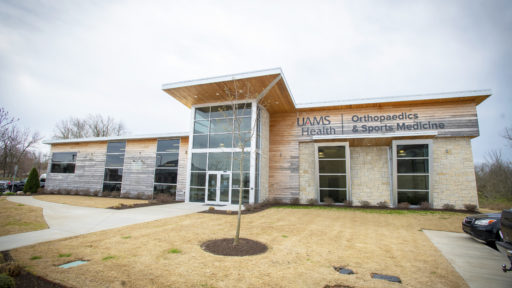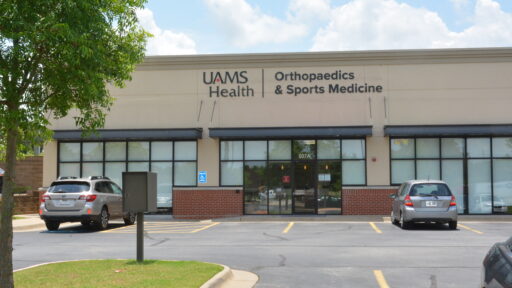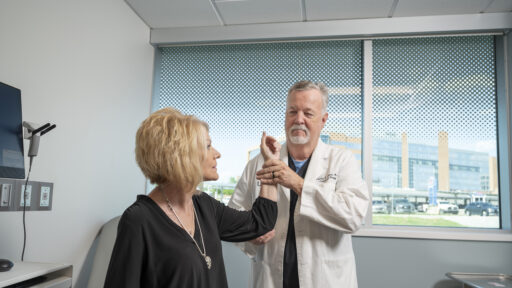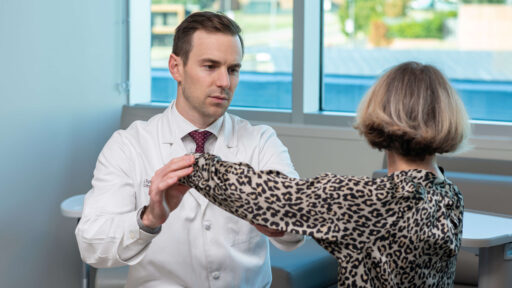Description
Dr. Wesley K. Cox talks about one of the most common issues he sees in his practice, rotator cuff injuries. Although it’s a common problem, the solution is not always surgery. Hear Dr. Cox explain how these injuries happen, alternative treatments to surgery and the surprisingly low number of patients who need surgery.
Video Player
Transcript
So one of the most common things that we see in the office is rotator cuff tears. It’s a very common complaint, obviously, that people have. A lot of people think they have a tear and they don’t. Rotator cuff pain can be very real, even without a tear. And surprisingly, a lot of people can have a rotator cuff tear and not even have any pain. And that’s where it gets sort of confusing.
Everybody seems to know somebody who’s had their rotator cuff repaired or done some therapy for a rotator cuff. And I always sort of joke with my patients — if you wear a sling into the grocery store, you’re going to meet a whole bunch of people who have been dealing with rotator cuff problems, and they’re happy to tell you their story. And it’s for a reason. Because rotator cuff pain can can be a huge, debilitating thing for patients and for all of us. And so we think of rotator cuffs like an athletic injury only, but the reality is there’s a certain amount of wear and tear of the rotator cuff that just happens over time. So even if you never do anything to “earn” a rotator cuff tear, if we never played professional baseball or never got tackled in an NFL game, there are still a lot of folks with rotator cuff tears that don’t know how they got them.
The good news for everybody is that most rotator cuff tears don’t need to be fixed. And so it’s not just about figuring out if you have a tear or not. It’s about figuring out is this rotator cuff problem consistent with your symptoms? Because sometimes you could have a rotator cuff tear that you might have had for several years and didn’t even know it. And then some other thing made your shoulder hurt. And so sorting out how your pain correlates with your MRI, for example, helps us figure out how to take care of you.
The rotator cuff is very complex, and I enjoy treating it because when you make people feel better after a rotator cuff problem, it’s a really good feeling because of how much life that it can take you out of when you’re dealing with it. They’re known to be most painful at night. So a lot of people will come in and complain of night pain, things them up when they’re asleep. But obviously during activity, it can be a big problem.
So the rotator cuff, we sort of fly over it in conversation, try not to. But the reality is it’s four different muscles. And those four muscles attach — if this is the ball of the ball and socket — they come from the back, couple from the top, and one from the front. And I explain it like reins on a horse. The rotator cuff serves to keep the head centered in the socket. Whether you’re standing up, lying down, leaning over, whatever you’re doing, the rotator cuffs never off duty, which is why it hurts at night when everything else can be relaxed. If you lay back and the head tries to fall back, it’s the rotator cuff job to keep it centered. And so while we think of it for Major League Baseball pitchers, just regular life has a high demand on the rotator cuff.
There are some of the rotator cuff tendons that are more commonly torn than others. Therefore, they’re the ones that are more commonly rehabbed that don’t need surgery and also the ones that do need surgical treatment .
The success rates have continued to improve, as has the ease with which we fix them when necessary. But in my office, about 15% of people with rotator cuff tears end up having surgery. And I think that’s something that we should all be striving for is getting people better without going to the operating room. And so when my own family members have had rotator cuff problems, we didn’t go straight to the operating room. We said, “Okay, we’re going to try this, this and this,” because rotator cuff tears aren’t dangerous. We fix them because they’re very bothersome, but not just because you have them.
There’s some crazy statistics that surprise a lot of people, but over the age of 65, there are as many people that have rotator cuff tears that don’t even know it as there are that don’t. If you just stop random goers and put them in an MRI scanner, they have no shoulder pain, a lot of them have rotator cuff problems, and that does not mean they need a rotator cuff surgery.
So figuring out exactly what’s wrong with your shoulder with regard to your rotator cuff, making sure it is indeed that is step one. Step two is what can we try? Well, it’s everything from stretches, physical therapy, sometimes cortisone injections. I’m for anything that works. So for a lot of people, it’s yoga, it’s acupuncture, it’s chiropractic care, it’s all different things. If you fail conservative treatment, that’s when we fix it. And only then. We will never fix rotator cuff tears — except in sort of extenuating circumstances — that haven’t failed conservative treatment. The good news is most people don’t feel conservative treatment, and so there’s reason for optimism, even if you’ve been told you have a tear.
The first rotator cuff repair was done in the early 1900s. And since 1910, not much has changed from a biology standpoint. But everything’s changed from what we know about that biology and how we fix it. So we now fix these arthroscopically. It doesn’t matter how big the tear is. They’re all fixed arthroscopically. We’ve even got the ability to do grafts. If your tendon is insufficient, we can use grafts from other places and so forth to make up for your lack of rotator cuff. And it gets very exotic if necessary.
But the ability to get people back to where they were before they hurt their rotator cuff is the goal of treatment — with or without surgery.
How we do rehab, especially here, is very conservative by many standards, but our practices are in data and principles. And so we follow the data. And data has proven that a lot of the early aggressive therapy that we once did for rotator cuff tears, we don’t do anymore because it can actually lead to earlier failure in some cases. And so it’s not just a “I had a rotator cuff tear.” I tell people that having a rotator cuff surgery is like having a car wreck. There’s thousands of different ways of severity, of velocity and what other what else might have gone on.
So step one: figure out if it’s your rotator cuff that’s actually hurting you or not. Step two: try everything except surgery. But don’t settle for a bad shoulder if you have a rotator cuff problem. The data is too good, and the surgeries have become too good at restoring normal anatomy to live with with a crummy shoulder. So I tell my patients don’t run to the operating room with a rotator cuff problem, but don’t run from it if you fail those things because our goal is to get you back and not have a rotator cuff problem that keeps you from doing the things you want to do.





